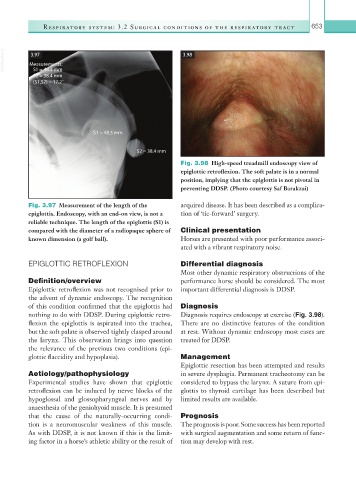Page 678 - Equine Clinical Medicine, Surgery and Reproduction, 2nd Edition
P. 678
Respir atory system: 3.2 Surgical conditions of the respir atory tr act 653
VetBooks.ir Measurements: 3.98
3.97
S1 = 48.3 mm
S2 = 38.4 mm
(S1,S2) = 17.2˚
S1 = 48.3 mm
S2 = 38.4 mm
Fig. 3.98 High-speed treadmill endoscopy view of
epiglottic retroflexion. The soft palate is in a normal
position, implying that the epiglottis is not pivotal in
preventing DDSP. (Photo courtesy Saf Barakzai)
Fig. 3.97 Measurement of the length of the acquired disease. It has been described as a complica-
epiglottis. Endoscopy, with an end-on view, is not a tion of ‘tie-forward’ surgery.
reliable technique. The length of the epiglottis (S1) is
compared with the diameter of a radiopaque sphere of Clinical presentation
known dimension (a golf ball). Horses are presented with poor performance associ-
ated with a vibrant respiratory noise.
EPIGLOTTIC RETROFLEXION Differential diagnosis
Most other dynamic respiratory obstructions of the
Definition/overview performance horse should be considered. The most
Epiglottic retroflexion was not recognised prior to important differential diagnosis is DDSP.
the advent of dynamic endoscopy. The recognition
of this condition confirmed that the epiglottis had Diagnosis
nothing to do with DDSP. During epiglottic retro- Diagnosis requires endoscopy at exercise (Fig. 3.98).
flexion the epiglottis is aspirated into the trachea, There are no distinctive features of the condition
but the soft palate is observed tightly clasped around at rest. Without dynamic endoscopy most cases are
the larynx. This observation brings into question treated for DDSP.
the relevance of the previous two conditions (epi-
glottic flaccidity and hypoplasia). Management
Epiglottic resection has been attempted and results
Aetiology/pathophysiology in severe dysphagia. Permanent tracheotomy can be
Experimental studies have shown that epiglottic considered to bypass the larynx. A suture from epi-
retroflexion can be induced by nerve blocks of the glottis to thyroid cartilage has been described but
hypoglossal and glossopharyngeal nerves and by limited results are available.
anaesthesia of the geniohyoid muscle. It is presumed
that the cause of the naturally-occurring condi- Prognosis
tion is a neuromuscular weakness of this muscle. The prognosis is poor. Some success has been reported
As with DDSP, it is not known if this is the limit- with surgical augmentation and some return of func-
ing factor in a horse’s athletic ability or the result of tion may develop with rest.

